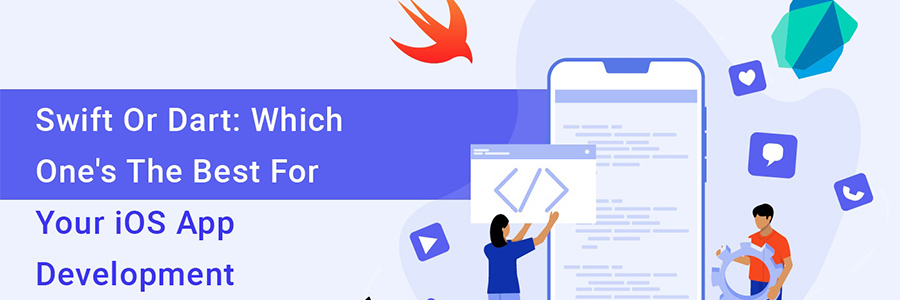Swift Or Dart: Which One’s The Best For Your iOS App Development

XpertLab Technologies Private Limited Ranked As Top 30 iPhone App Development Companies
8th July 2021
Build an API With Fastify and MongoDB
16th July 2021Mobile app developers conduct a lot of research for which programming language & frameworks would work the best for them. All app developers and entrepreneurs need to know which language is best for writing code & delivering remarkable, user-friendly mobile apps. There is, however, no correct answer to which one’s the best. iOS programming languages provide a vast scope of usefulness. Ultimately, the aim is to convey apps that are attractive, work fast, and render all that the potential app user needs; native iPhone app development seems to be more interesting with the launch of the Swift programming language. What you must know about Swift is that it is a fast, advanced, and secure programming language. Also, Experts are still working on its advancements and functionalities. To build iOS apps with native devices, we need to use Apple’s iPhone development tools & frameworks. Several factors should be considered to determine the difference between these 2 programming languages. Before diving into the factors, let’s first have a quick introduction to these two languages.
Introduction To Dart
Google launched Dart in 2011, and it can be used to develop both iOS and Android apps with a single codebase. This is an open-source programming language, and it aims to create a front-end UI for mobile and web apps. Unlike other languages, this one was designed to improve the development process by making it quick and comfortable for app developers. Therefore, it comes with a somewhat extensive set of in-built tools. This general-purpose programming language has a similar syntax to Java and C++. Thus, it becomes easy for developers to know other programming languages. Dart-based apps can give a native-like feel for both iOS and Android with a single codebase, thus saving time & costs less to build separate native apps for two, Android and iOS.
Introduction To Swift
Swift is an open-source programming language developed by Apple. It is the result of modern research combined with years of experience creating Apple platforms. It was launched in 2014 and became famous, outdating Objective-C as the primary language to develop native iOS apps. This programming language is remarkable for its intensive documentation, coding speed, and imaginative methods. Also, Swift’s design patterns can also be utilized for work area, web, and worker apps. The best climate used to build native apps using Swift is XCode. Swift app development is claimed to be simple, fast, and dependent on designs that are known & loved by the native area.
Significant Factors For Comparison Between Dart Vs. Swift
1. Development Time
App developers probably don’t like long development processes, as there are so many other app development opportunities waiting in the line. Effort & time becomes one of the most critical decisions for them as well as their clients. Long app development hours would increase the budget of the clients. XCode is used for both programming languages to determine the developing process. Where time is concerned, Swift excels at Dart’s expectations. Most developers prefer swift over Dart for native app development. However, you should know that the additional Dart build framework is the correct choice too. It’s worth mentioning that the development time is essential for both small & big projects.
2. Profiling
Profiling estimates the iOS app’s presentation. Developers use XCode with Swift programming language, which offers an all-inclusive framework that allows the iOS app’s monitoring. Time Profile enables to assess CPU strings with multiple button clicking. It calculates the performance of an iOS app, focusing on CPU, resources, and memory. Dart provides incredible documentation on app profiling. We can use an IDE or use an order line. Through this, we can show the time needed for Dart app profiling. But, profiling time relies on the app alone. Native app frameworks render much better performance than others.
3. Testing
Testing with both these programming languages is very different, yet both are strong and viable alternatives. Talking about Dart, it has a testing framework that allows conducting several tests, including user interface and practical level tests. While the testing of native iOS mobile apps is very basic in Swift. It has its testing framework considered XCTest that allows us to test user interface modules, integration, execution, and more.
4. Reloading
iOS app requires reloading & testing it with a device or a test framework. While doing this, the app developer can evaluate the code and understand how the progressions affect the whole app. It is one of the basic strides in app projects. Dart programming language uses hot reload usefulness. It is viewed as a lot faster with reference to presenting changes in the code. In native iOS app development with Swift, transforming one component requires renaming the interface and modifying native code to test if any change is seen inside the app while running it on a test framework or a device. It usually takes about 12 seconds. Currently, SwiftUI allows hot reloads, and we can use InjectionIII to add new functionalities quickly.
5. Accessibility Support
Accessibility support is more efficient with Swift than Dart. Swift has an in-built user interface kit that simplifies the building process. Dart recommends using XCode’s Accessibility Inspector, which doesn’t have an internal support system. App developers use MacOS with installed XCode using Swift. The incorporation of the Dart app depends on NeverCode to complete the integration.
The Bottom Line: Which One’s The Best?
There is no exact answer for this one. Dart, an open-source iOS programming language, has more scope if you want to create iOS & Android apps simultaneously. On the other hand, Swift will proceed to develop and enhance the development of the native app extends. It provides immense advantages for cross-platform app development, and neglecting it could be disastrous. Moreover, there are high chances that Swift will grow in the coming time due to its reasonable new framework.





